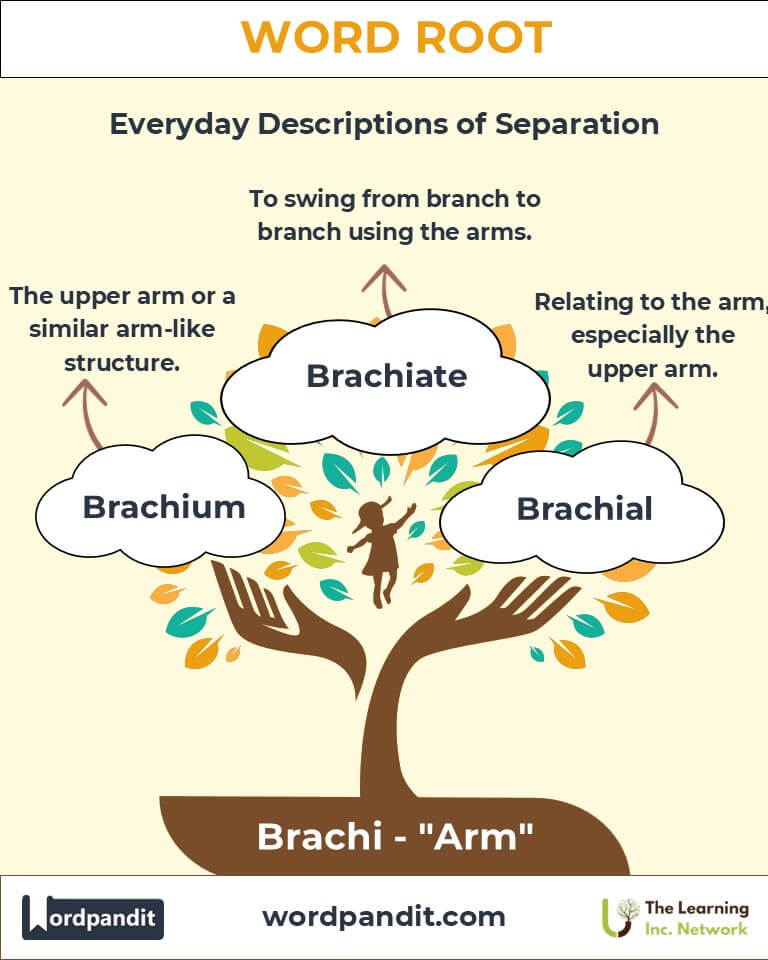Brachi: The Root of Arm in Language and Science
Discover the fascinating world of the root "Brachi," originating from Latin, meaning "arm." From anatomical terms like "brachial" to marine life references like "brachiopod," this root reveals the diverse ways the concept of the arm influences language, science, and culture.

Table of Contents
- Introduction: The Power of Brachi
- Etymology and Historical Journey
- Mnemonic: Unlocking the Power of Brachi
- Common Brachi-Related Terms
- Brachi Through Time
- Brachi in Specialized Fields
- Illustrative Story: Brachi in Action
- Cultural Significance of the Brachi Root
- The Brachi Family Tree
- FAQs about the Brachi Root
- Test Your Knowledge: Brachi Mastery Quiz
- Conclusion: The Living Legacy of Brachi
Introduction: The Power of Brachi
Have you ever wondered how the structure of the arm has inspired language? The root "Brachi" (pronounced BRAH-kee) derives from Latin, meaning "arm." It underpins terms that describe arm-related anatomy and even extend metaphorically to branching forms in nature and technology. Whether in biology or engineering, "Brachi" reveals how essential and versatile the arm is across fields.
Etymology and Historical Journey
The root "Brachi" comes from the Latin word brachium, meaning "arm." In classical Latin, it referred explicitly to the upper arm but evolved to encompass broader meanings, including branches or appendages in various contexts. Over centuries, this root influenced words in anatomy, zoology, and even robotics, maintaining its foundational link to the arm's function and structure.
Mnemonic: Unlocking the Power of Brachi
To remember "Brachi," imagine a tree's branches reaching out like arms toward the sky. This imagery connects the root's meaning of "arm" with its metaphorical applications, such as extensions or branching.
Mnemonic Device: "Brachi—where arms branch out in science and nature."
Common Brachi-Related Terms
- Brachial (BRAH-kee-uhl): Relating to the arm, especially the upper arm.
- Example: "The brachial artery supplies blood to the arm and hand."
- Brachiopod (BRAH-kee-oh-pod): A marine animal with arm-like structures for feeding.
- Example: "Fossils of brachiopods reveal their ancient lineage and unique anatomy."
- Brachiate (BRAH-kee-ate): To swing from branch to branch using the arms, as in certain primates.
- Example: "Gibbons are well-known for their ability to brachiate effortlessly through the trees."
- Brachioplasty (BRAH-kee-oh-plas-tee): A surgical procedure to reshape or tighten the upper arm.
- Example: "After significant weight loss, she opted for brachioplasty to improve her arm's appearance."
- Brachium (BRAH-kee-um): The upper arm or a similar arm-like structure.
- Example: "The brachium connects the shoulder to the elbow in humans."
Brachi Through Time
- Brachium in Ancient Anatomy: The term "brachium" appeared in early anatomical studies, solidifying its role in describing arm structures.
- Brachiopod Evolution: Once dominant marine organisms, brachiopods have existed for over 500 million years. Their name highlights their arm-like feeding mechanisms.
- Modern Robotics and Brachiate Motion: In robotics, "brachiate" movements inspired the design of robotic arms mimicking primate agility.
Brachi in Specialized Fields
- Medicine:
- Brachial Plexus: A network of nerves supplying the arm and hand.
- Example: "Injuries to the brachial plexus can cause significant arm dysfunction."
- Zoology:
- Brachiopods: Marine invertebrates that use arm-like structures to filter food.
- Example: "Brachiopods are often mistaken for clams due to their shell-like appearance."
- Robotics:
- Brachiate Movement: Used in designing mechanical arms or robots mimicking primates.
- Example: "The robotic arm's brachiate motion allows it to navigate complex environments."
- Fitness:
- Brachial Workouts: Exercises targeting the upper arm muscles, such as biceps and triceps.
- Example: "Strengthening brachial muscles improves overall arm mobility."
Illustrative Story: Brachi in Action
In a bustling city, a scientist studied the intricate movements of primates in the wild. Inspired by their brachiating agility, she developed a robotic arm capable of swinging through disaster zones to deliver aid. Meanwhile, a paleontologist discovered a fossilized brachiopod, unlocking secrets of ancient ecosystems. From swinging arms to ancient shells, the legacy of "Brachi" connects innovation and history.
Cultural Significance of the Brachi Root
The arm has long symbolized strength and capability. In ancient art and literature, arms often represented power and support. The word "Brachi" encapsulates this symbolism, extending it to fields like medicine and technology. Its applications reflect our enduring fascination with the arm's versatility and metaphorical reach.
The Brachi Family Tree
- Branch (Latin: "to extend"):
- Example: A tree's branches spread like arms.
- Pod (Greek: "foot"):
- Example: In "brachiopod," the root highlights arm-like appendages combined with "foot."
- Flex (Latin: "to bend"):
- Example: Flexion involves bending the arm at the elbow.
FAQs About the Brachi Root
Q: What does "Brachi" mean?
A: "Brachi" is a Latin root meaning "arm." It is commonly used in anatomy to describe structures related to the arm, such as the brachial artery, and extends metaphorically to other areas, such as brachiation in primates, which refers to swinging with arm-like movements.
Q: What is a brachiopod, and why is it significant?
A: A brachiopod is a marine invertebrate with arm-like structures used for feeding. These structures, called lophophores, help filter food particles from water. Brachiopods are often studied in paleontology because their fossils provide valuable insights into ancient marine ecosystems and evolutionary biology.
Q: How does "brachiate" apply to both primates and robotics?
A: In primates, brachiation refers to their ability to swing from branch to branch using their arms, as seen in gibbons. This movement is highly efficient and agile. In robotics, brachiation inspires designs for robotic arms or mechanisms that mimic these swinging motions, particularly for navigating complex environments.
Q: What is the brachial plexus, and why is it important?
A: The brachial plexus is a network of nerves originating from the spinal cord and extending into the arm. It controls movement and sensation in the shoulder, arm, and hand. Injuries to this network can result in partial or complete loss of arm function, making it a critical focus in medical diagnoses and treatments.
Q: What is brachioplasty, and who might consider it?
A: Brachioplasty is a surgical procedure to reshape or tighten the upper arm, often after significant weight loss or due to aging. It helps individuals achieve a smoother, more toned arm appearance and can restore confidence in those who feel self-conscious about excess skin or tissue.
Q: Why is the term "brachium" used metaphorically in fields like engineering?
A: The term brachium, meaning "arm," is often used metaphorically in engineering and robotics to describe mechanical arms or structures that perform tasks similar to human arms, such as lifting or manipulating objects. This metaphorical usage highlights the functional similarity between human anatomy and technological designs.
Q: Are all brachi-related terms about the human arm?
A: No, while many terms focus on the human arm, others extend to broader contexts. For example, brachiopods are marine animals, and brachiation refers to movement in primates. The root also applies metaphorically to branching structures, emphasizing its versatility.
Q: What are brachial exercises, and why are they beneficial?
A: Brachial exercises target the muscles of the upper arm, such as the biceps and triceps. These exercises are crucial for building strength, improving arm mobility, and supporting daily activities like lifting and pulling. Strengthening the brachial region also enhances overall upper body stability.
Test Your Knowledge: Brachi Mastery Quiz
1. What does "Brachi" mean?
2. Which word describes swinging with arms?
3. What is a brachial artery?
4. What is the purpose of brachioplasty?
5. Which field studies brachiopods?
Conclusion: The Living Legacy of Brachi
The root "Brachi" symbolizes the arm's pivotal role in anatomy, movement, and innovation. From brachiopods to brachial arteries, its applications span disciplines, reflecting the arm's importance in both physical and metaphorical realms. As science and technology evolve, "Brachi" will continue to inspire discoveries and bridge the gaps between biology, engineering, and culture.












Thanks for this informative post.Keep publishing.